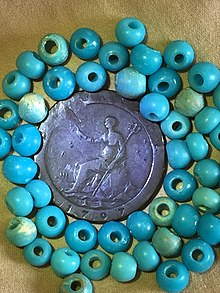| This article is an orphan, as no other articles link to it. Please introduce links to this page from related articles; try the Find link tool for suggestions. (November 2021) |

The Chief's bead, named "ti-a, co-mo-shack" by North American Natives, are blue glass trade beads used during the late 18th century and early 19th century up and down the West coast of North America and the Columbia River Basin. The Chief's beads were sought by Native American tribes in preference over beads of other colors because they were blue. An indication of the importance of the blue Chief's bead was that after the Lewis and Clark Expedition returned from their 1803–1806 expedition of discovery to find a route from Missouri to the Pacific Ocean, the leader Captain Meriwether Lewis stated that if he were to return, he would make the blue bead half to two-thirds of his trading goods.
The Chief's bead was about the size of a currant or large pea and seldom perfectly round. They were normally 2 or 3 carats in size. The beads were measured at 50 to 70 against the weight of the English Soho Mint penny, close to the modern ounce and were traded by the fathom or by the yard.
Types of manufacturing
There were three types of Chief's beads manufactured: reed-wound beads from China, furnace-wound beads from Bavaria, and wire-wound beads from numerous other locations.
Reed wound beads
These beads were a cottage industry in China. Reeds would be soaked in a clay slurry. Two individuals would rotate the reed and another person would trail the hot glass over the reed. The hot beads and reed would be laid in a clay bed to cool. When cool, they would be stripped from the reeds. This method of manufacture was used as far back as the eighth century CE until the late 1930s.
Furnace wound beads
These beads were manufactured primarily in Bavaria. An iron rod, covered with a kaolin clay bead release, was dipped into the molten glass. The workmen would then separate small quantities of glass and form them into beads, which they slid down the length of the rod. The bead would be slid off into a warmer to anneal and cool. This type of work possibly started as early as the eighth century CE. and was still being done in 1969.
Wire wound or out of furnace wound beads
This is the original, and by far the oldest method of winding a bead on a mandrel. The mandrel can be used to dip a small amount of melted glass from the melted source and then rolled into a bead. An alternate method is to use two rods, one to dip the glass from the melt, and allow the trail to be wound around the other rod. The rods develop iron oxide from the fire, which gives them a natural release agent for the beads. This often gives the wire wound beads, a dark brown core. This type of manufacture is still occurring.
References
- ^ Lewis, Meriwether; Clark, William (2004). Moulton, Gary E. (ed.). The Definitive Journals of Lewis & Clark. University of Nebraska Press. ISBN 9780803280328.
- Quimby, George I. (2011). "Trade Beads and Sunken Ships". In Dunell, Robert C.; Hall, Edwin S. (eds.). Archaeological Essays in honor of Irving B. Rouse. New York: De Gruyter Mouton. pp. 231–246. doi:10.1515/9783110803259.231. ISBN 978-90-279-7834-9. Retrieved 20 August 2021.
- Ned Eddins. "Indian Trade Beads". The Fur Trade Role in Western Expansion. Archived from the original on 4 March 2021. Retrieved 20 August 2021.
- Jackson, Donald Dean (1962). Letters of the Lewis and Clark Expedition: with related documents, 1783-1854. University of Illinois Press (Original from the University of Virginia). p. 728.
- Beagle, J.C. (ED) 1967. The Journals of Captain Cook on his voyage of discovery. Pages 346 and 1418, Vol 111, four Volumes and Portfolio. Hakluyt Society Extra Series No. 36, Cambridge.
- Liu, Robert K., PhD, Chinese Glass Beads and Ornaments. The Bead Journal, Vol. 1, No. 3, Winter 1975. ISSN 0094-2448. Key title: Bead Journal
- Wang, Kuan-Wen. (Fall 2015) Scientific Analysis of Early Iron Age Glass Beads from Taiwan. SAS Bulletin. News letter of the Society for Archaeological Sciences. Volume 38, No. 3.
- Jargstorf, Sibylle. (1995) Glass Beads from Europe. Pg 87. Schiffer. ISBN 0-88740-839-7 (pbk.)
- Karklin, Karlis. (2016) The Fichtelgebirge Bead and Button Industry of Bavaria. BEADS: Journal of the Society of Bead Researchers. Volume 28, Article 5. ISSN 0094-2448. Key title: Bead Journal
- Harris, Elizabeth. A Bead Primer. The Bead Museum. ISBN 0-9618396-0-0


